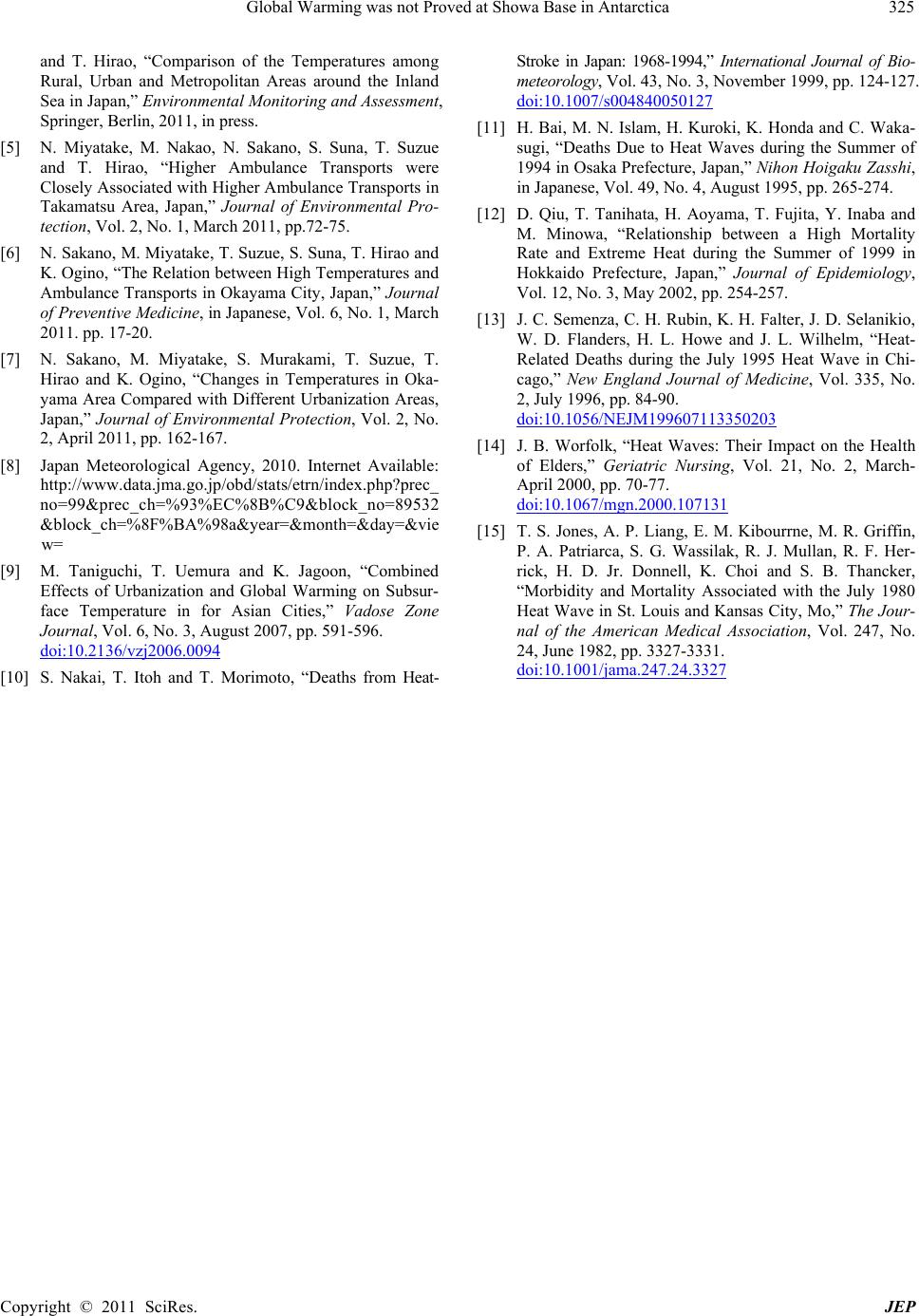
Global Warming was not Proved at Showa Base in Antarctica 325
and T. Hirao, “Comparison of the Temperatures among
Rural, Urban and Metropolitan Areas around the Inland
Sea in Japan,” Environmental Monitoring and Assessment,
Springer, Berlin, 2011, in press.
[5] N. Miyatake, M. Nakao, N. Sakano, S. Suna, T. Suzue
and T. Hirao, “Higher Ambulance Transports were
Closely Associated with Higher Ambulance Transports in
Takamatsu Area, Japan,” Journal of Environmental Pro-
tection, Vol. 2, No. 1, March 2011, pp.72-75.
[6] N. Sakano, M. Miyata ke, T. Suzue, S. Suna, T. Hirao and
K. Ogino, “The Relation between High Temperatures and
Ambulance Transports in Okayama City, Japan,” Journal
of Preventive Medicine, in Japanese, Vol. 6, No. 1, March
2011. pp. 17-20.
[7] N. Sakano, M. Miyatake, S. Murakami, T. Suzue, T.
Hirao and K. Ogino, “Changes in Temperatures in Oka-
yama Area Compared with Different Urbanization Areas,
Japan,” Journal of Environmental Protection, Vol. 2, No.
2, April 2011, pp. 162-167.
[8] Japan Meteorological Agency, 2010. Internet Available:
http://www.d ata.j ma.go.jp/obd/ sta t s/et r n/i n dex.php?pre c_
no=99&prec_ch=%93%EC%8B%C9&block_no=89532
&block_ch=%8F%BA%98a&year=&month=&day=&vie
w=
[9] M. Taniguchi, T. Uemura and K. Jagoon, “Combined
Effects of Urbanization and Global Warming on Subsur-
face Temperature in for Asian Cities,” Vadose Zone
Journal, Vol. 6, No. 3, August 2007, pp. 591-596.
doi:10.2136/vzj2006.0094
[10] S. Nakai, T. Itoh and T. Morimoto, “Deaths from Heat-
Stroke in Japan: 1968-1994,” International Journal of Bio-
meteorology, Vol. 43, No. 3, November 1999, pp. 124-127.
doi:10.1007/s004840050127
[11] H. Bai, M. N. Islam, H. Kuroki, K. Honda and C. Waka-
sugi, “Deaths Due to Heat Waves during the Summer of
1994 in Osaka Prefecture, Japan,” Nihon Hoigaku Zasshi,
in Japanese, Vol. 49, No. 4, August 1995, pp. 265-274.
[12] D. Qiu, T. Tanihata, H. Aoyama, T. Fujita, Y. Inaba and
M. Minowa, “Relationship between a High Mortality
Rate and Extreme Heat during the Summer of 1999 in
Hokkaido Prefecture, Japan,” Journal of Epidemiology,
Vol. 12, No. 3, May 2002, pp. 254-257.
[13] J. C. Semenza, C. H. Rubin, K. H. Falter, J. D. Selanikio,
W. D. Flanders, H. L. Howe and J. L. Wilhelm, “Heat-
Related Deaths during the July 1995 Heat Wave in Chi-
cago,” New England Journal of Medicine, Vol. 335, No.
2, July 1996, pp. 84-90.
doi:10.1056/NEJM199607113350203
[14] J. B. Worfolk, “Heat Waves: Their Impact on the Health
of Elders,” Geriatric Nursing, Vol. 21, No. 2, March-
April 2000, pp. 70-77.
doi:10.1067/mgn.2000.107131
[15] T. S. Jones, A. P. Liang, E. M. Kibourrne, M. R. Griffin,
P. A. Patriarca, S. G. Wassilak, R. J. Mullan, R. F. Her-
rick, H. D. Jr. Donnell, K. Choi and S. B. Thancker,
“Morbidity and Mortality Associated with the July 1980
Heat Wave in St. Louis and Kansas City, Mo,” The Jour-
nal of the American Medical Association, Vol. 247, No.
24, June 1982, pp. 3327-3331.
doi:10.1001/jama.247.24.3327
Copyright © 2011 SciRes. JEP